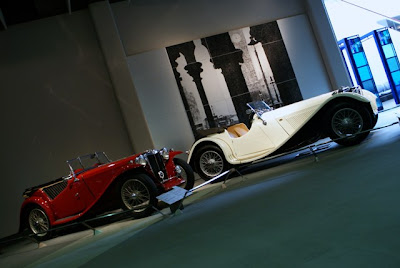 More contrast can be seen here between the 1938 Cadillac Series 60 Special (left) and the 1938 Fiat 500 Topolino (right) which exemplifies the differing directions the companies were headed. Cadillac was trying to produce an innovative and desireable car while Fiat was headed in the opposite direction size-wise to produce a car that was mechanically advanced but more compact. Again, its easy to draw parallels with SUVs and the upcoming crop of mini-cars like the Smart or Toyota iQ.
More contrast can be seen here between the 1938 Cadillac Series 60 Special (left) and the 1938 Fiat 500 Topolino (right) which exemplifies the differing directions the companies were headed. Cadillac was trying to produce an innovative and desireable car while Fiat was headed in the opposite direction size-wise to produce a car that was mechanically advanced but more compact. Again, its easy to draw parallels with SUVs and the upcoming crop of mini-cars like the Smart or Toyota iQ. 
The museum, of course, had its fair share of high performance cars many of which are some of the most famous racing machines in the world. Machines like this 1930 Alfa Romeo 6C 1750 Gran Sport (left) and 1926 Bugatti Type 35B (right). Elsewhere in the museum they had a 1914 Stutz Bearcat Series F and just beyond the Bugatti was a 1930 Bentley Speed 6.



Then again, Toyota didn't let everyone else have the limelight and, towards the end of the tour, steals the spotlight back with a pristine example of their 1970 Toyota 7 race car as well as a 1967 Toyota 2000GT.

But by far and away one of the most surprisingly beautiful cars was this 1936 Lancia Astura Tipo 233C. I'm not sure if it was the blue colour, the tear-drop front and rear fenders, or the body shape tapering to that pointed nose, but it was striking in person.

There was also the museum annex, which at the time had display with various cars together with memorabilia from that era. Examples like this 1960's Mazda Carol was backed up by a collection of 1960's plastic dolls like Barbie's.




 Just beyond that, however, is one of the absolute best exhibits I've ever seen- a gigantic hall showing not only the development and mechanics of car parts, but the manufacturing process as well. The huge circle above is actually a 3-screen movie theatre showing a film tour of a Toyota assembly plant producing a car from start to finish.
Just beyond that, however, is one of the absolute best exhibits I've ever seen- a gigantic hall showing not only the development and mechanics of car parts, but the manufacturing process as well. The huge circle above is actually a 3-screen movie theatre showing a film tour of a Toyota assembly plant producing a car from start to finish.  A place like this is just what a cutaway-o-phile like me enjoys, with displays of nearly all the mechanical car components and how they work. You can turn a steering wheel and watch the rack slide, press a button to see how a differential works, step on a clutch pedal to watch a clutch engage and disengage, or shift gears and watch the transmission swap cogs (above).
A place like this is just what a cutaway-o-phile like me enjoys, with displays of nearly all the mechanical car components and how they work. You can turn a steering wheel and watch the rack slide, press a button to see how a differential works, step on a clutch pedal to watch a clutch engage and disengage, or shift gears and watch the transmission swap cogs (above).  Moving to the main floor shows how car assembly have progress from men on assembly lines to robots performing a large part of the production and assembly. Many of the machines there are 20 or so years old and, likely, were retired from Toyota factories and brought here to be used as learning tools. As seen above, pushing a button allows guests to watch a body shell move down the line to be "welded" by various robotic arms.
Moving to the main floor shows how car assembly have progress from men on assembly lines to robots performing a large part of the production and assembly. Many of the machines there are 20 or so years old and, likely, were retired from Toyota factories and brought here to be used as learning tools. As seen above, pushing a button allows guests to watch a body shell move down the line to be "welded" by various robotic arms. 
As I mentioned before, I love how things work and I love learning about them interactively. I do admit that forgoing Nagoya Castle may seem a bit petty but to me, these things point toward the future and there is just as much history and progress found here as there is going to a temple or watch a city sprawl outward from a holy shrine. And having done lots of the latter, the museum was a great chance to see something else.
Tomorrow I head off to Sapporo which is something I've been looking forward to. The train ride is nearly 9 hrs long but I have my music and my books, so it'll be good.
The following three pictures are shot at (from top to bottom) f22, f8, and f2.

Speaks for itself I think =)... one last one...



No comments:
Post a Comment